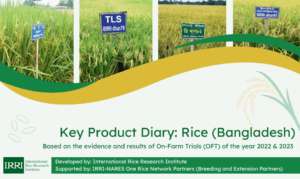This chapter explores how, in Bangladesh, conservation agriculture improves soil physical, biochemical, and biological health, leading to improved cropping system productivity while minimizing environmental damage. We also examine key challenges and potential solutions to promote the wider expansion of conservation agriculture practices in the intensive rice-based cropping systems of South Asia, in particular in Bangladesh.
Abstract
Agriculture in Bangladesh is subsistence-oriented, with traditional management practices still widespread. More recently, new management options have been introduced which have led to substantial improvements in national food and nutrition security as well as a decline in rural poverty.
Globally, Bangladesh is the second largest consumer per capita of rice (about 200 kg year). Between 77% and 80% of the country’s arable land is used for rice-based crop production. Depending on local edaphic and hydrologic conditions, rice may be grown over three key cropping periods: aman (grown in the wet season and rainfed from monsoon rains); boro (grown in winter and fully irrigated); and aus (grown in spring largely using pre-monsoon rainfall).
To meet the increasing food and nutrition demands of Bangladesh’s increasing population, farmers apply high doses of agrochemicals (e.g., fertilizers, pesticides, and herbicides) without realizing the deleterious effect overapplication has in terms of depleting soil organic matter, increasing both macro- and micro-nutrient insufficiencies, increasing water-logging and/or poor drainage, and increases in soil salinity and acidity.
In addition, intensive rice cultivation under irrigation is the greatest source of greenhouse gas emissions from cropland. In 2014, global greenhouse gas emissions from rice cultivation were 192 megatons. To mitigate the adverse effects on soil health of traditional intensive crop management, and also to reduce greenhouse gas emissions from food grain production, conservation agriculture has been proposed as a key tool to sustainably maintain or increase agricultural productivity and profitability while preserving or enhancing natural resources and the environment.
Conservation agriculture is based on three principle strategies: minimal disturbance of soil; maintaining soil cover through the retention of crop residues and/or cover crops; and the use of crop rotations. This chapter explores how, in Bangladesh, conservation agriculture improves soil physical, biochemical and biological health, leading to improved cropping system productivity while minimizing environmental damage. We also examine key challenges and potential solutions to promote the wider expansion of conservation agriculture practices in the intensive rice-based cropping systems of South Asia, in particular in Bangladesh.
Read the study (not open access)
Hossain A et al. (2021) Conservation Agriculture Improves Soil Health: Major Research Findings from Bangladesh. In: Jayaraman S, Dalal RC, Patra AK, Chaudhari SK (eds) Conservation Agriculture: A Sustainable Approach for Soil Health and Food Security. Springer, Singapore.






